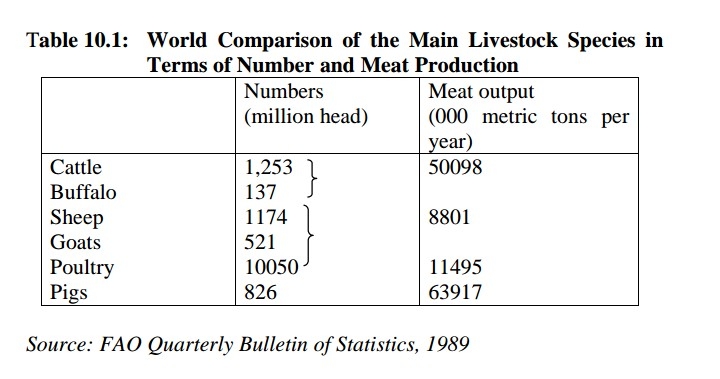The estimated world pig population of 286 million (FAO, 1988) means that there is approximately one pig to every six people in the world.
Although pigs are numerically fewer than some other domestic species, more pig meat is produced than other meat (Table10.1). This reflects the greater productivity of the pig when compared with other domestic species
Distribution and consumption
The distribution of pigs throughout the world is not uniform. Nearly half the world’s pig population is in Asia, with a further 30 percent in Europe and the USSR. In contrast, the population in large parts of the tropical and sub-tropical developing regions (e.g. Africa and Latin America) is
relatively small (figure10: 1). Nevertheless, the increase in the world pig population over the last decade is largely attributable to increase within the developing world, which now constitutes some 60 percent of the world population of pigs. It is noteworthy that the majority of the pigs in
the developing world are located in one Asian country, namely China.
Similarly, marked differences exist in the consumption patterns of pig meat throughout the world. In some parts of Europe, annual per capita consumption of pig meat is over 50 kg, and represents some 60 per cent of the total meat consumed. At the other end of the scale in areas of the developing world and particularly in Africa, estimated annual per capital consumption ranges from 1 to 3kg, and form less than 10 per cent of the total meat diet.
The reasons for the uneven distribution of pigs throughout the tropical and sub-tropical world are manifold. In tropical Asia and parts of China, pork is the predominant component of the diet. On the other hand, in areas where the Islamic religion prevails, e.g. the Middle East, Pakistan and part of Africa, Muslims are forbidden to eat any pig meat. Similarly,
believers in the Jewish faith are instructed not to eat pork meat, and Zionist sects occur throughout the developing world. Social factors also play a part and these may have a positive or a negative effect on the pig population. In some Pacific islands, such as Tonga and Papua New
Guinea, pigs are highly regarded as a source of wealth and associated with marriage customs. On the other hand, in Africa people have traditionally obtained their meat supplies mainly from ruminants, particularly cattle and this preference persists.
The pig has historically been considered an unclean animal, wallowing in filth, an object of distaste and a hazard to human health. Clearly, there is some truth in this assumption if the pig is used as a scavenger but the exact opposite pertains if the pig is well managed under confined
conditions.
Climate has an influence on distribution. Pigs can be reared almost anywhere given suitable housing and management. But in situations of extreme temperatures, humidity or lack of rainfall they cost more to produce, because of the need for more expensive housing and because suitable feeds may not be available.
The Potentials and Constraints to Pig Production in Developing Countries
The world trend is towards the consumption of more white than red
meat. Thus the potential for increased meat production from pigs in the developing world is enormous. When compared with cattle and other ruminants, pigs have some major potential advantages, namely:
• They produce meat without contributing to the deterioration of the natural grazing lands. This is of paramount importance in
relation to the current steady desertification, soil erosion and loss
of productive land in tropical and sub-tropical parts of the world.
Overstocking and consequent overgrazing by ruminant is a primary cause of this degradation.
• They covert concentrate feed on meat twice as efficiently as ruminants.
• They possess the potential to be highly productive. Because they are capable of producing large litters after a relatively short gestation period, and have a short generation interval and grow rapidly, their output in terms of yield of meat per tonne of live weight of breeding females per year is in the region of six times that of cattle.
• If confined maximum use can be made of their manure and effluent.
• Their relatively small size, when compared with cattle, provides for more flexibility in marketing and consumption.
• The meat pigs produce is particularly suitable for processing: some of the processed products have a longer shelf life than fresh meat, and can thus be distributed to a wider section of the
population.
• Quicker turn-over rate to investment compared with cattle. Apart from the social and religious constraints mentioned, other constraints to pig production are:
• As simple-stomached animals, they compete directly with humans for feed, especially the staple grains and oilseeds.
This can be partly overcome by making maximum use of crop by-product, waste feeds and grain unsuitable for human consumption.
• They cannot provide a source of draught power for farming operations.
• Since they tend to be raised close to human habitation, their effluent may cause a pollution problem
• Because pigs and man are co-hosts to a number of parasites, if pigs are not confined they can pose a problem to human health.



0 Comments
Comment